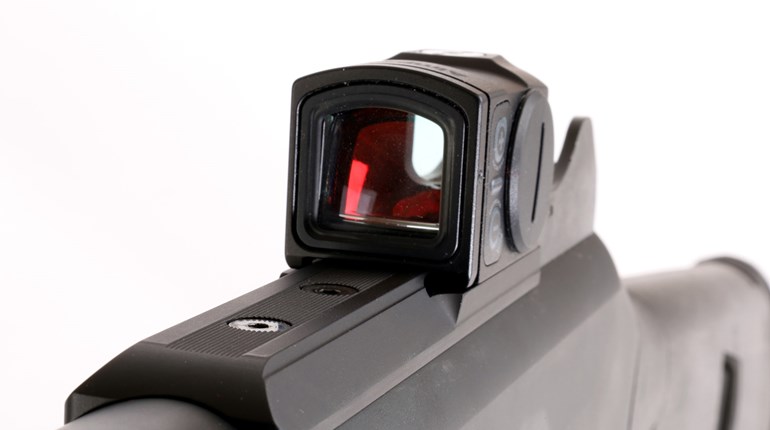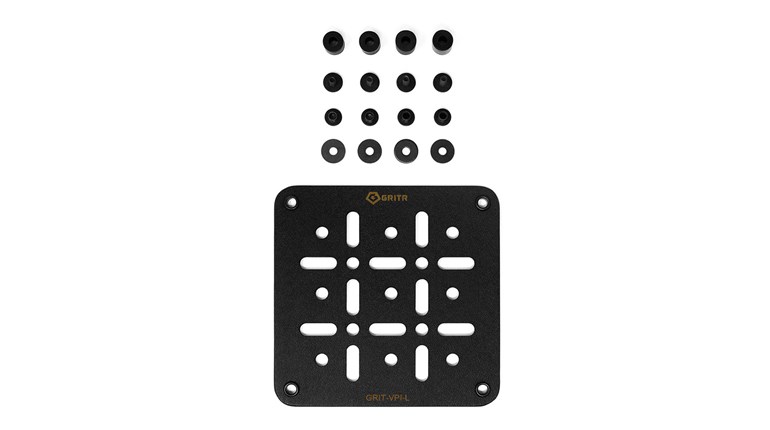Welcome to another “I Carry” segment, bringing you firearms and gear for personal defense. Today we’re taking a look at an optics-ready Glock handgun, the new Acro mini-red-dot from Aimpoint and a Mission First Tactical holster. Let’s take a closer look at this gear.
Firearm: Glock G45 MOS ($699)
Introduced at the 2019 NRA Annual Meetings & Exhibits in Indianapolis, IN, Glock’s G45 MOS (for Modular Optic System) builds on the legacy G45 and G19X pistols. We’ve covered the G45 previously here on “I Carry,” and little has changed with this iteration other than the optics mounting system, but let’s briefly recap some of the G45’s features.
Many scoffed at the setup of the G19X when it first arrived on the handgun scene. “It’s backwards!” many cried, given that conventional wisdom has the slide being easier to conceal, and the grip needing to be shortened. In the majority of cases, that’s not incorrect; whether carried strong-side inside/outside the waistband or even appendix, the grip is going to give more problems with printing as a general rule. For those who carry Glocks, the G19 grip/G17 slide combination would be more appealing, and is in fact a common custom alteration. When the G19X was first rumored, many assumed that was the combination.
Instead, the diametric opposite happened: Glock put a G19 slide on a G17 frame. The G45 carried the same styling in an all-black handgun with forward cocking serrations, and the reverse setup has yet to be released out of Austria. Again, while folks complain, it’s worth noting that the G19X/G45 is the same arrangement as the Colt Commander, which has enjoyed a certain level of popularity through the many decades it has existed. Benefits of this arrangement are primarily in the shootability of the gun, as a full, three-finger grip is easy to achieve and maintain.
On the MOS side of things, Glock ships the G45 MOS with four mounting plates covering a variety of red-dot sights. Additionally, Glock has worked with companies like SIG Sauer for the Romeo line and with Aimpoint for the Acro that we’ll be covering in a moment. Chances are pretty good that no matter what optic you want to put on a Glock MOS pistol, there’s a plate out there to fit.
I do want to touch on something about which to be careful when using any plate system. The advantage of the plate system is, naturally, that many different options are possible. The disadvantage is that it adds a level of complexity and possible problems, as two pairs of screw are needed instead of a direct-mount’s single pair. You have to attach the plate to the slide, then the optic to the plate—that’s now two places you need to have proper torque applied to attach, two places to Loctite and two places to check. When you have a milled slide, everything’s simpler. There are certain optics, like the one we’re about to cover, that require it…
Optic: Aimpoint Acro P-1 ($660)
Also new for 2019, Aimpoint’s first pistol-mounted optic, the Acro P-1, offers an enclosed emitter, 3.5 MOA red dot, night-vision capability and the ability to change out the battery without taking the Acro off the pistol. It’s a robust sight with a unique profile, and, as I mentioned earlier, it requires a unique mounting system. The Acro looks like a red dot sight you’d put on a carbine, only smaller, and the mount reinforces that. A specialized plate bolts to any number of optics-ready handguns, like the Glock G45 MOS covered above, and the Acro then attaches to that plate in a manner similar to the red dot you might put on your AR-15. The enclosed emitter of the Acro makes the mounting plate a necessity – you simply can’t put a couple screws through the body like you can on a Trijicon RMR or a Leupold DeltaPoint.
However, this unconventional design offers a couple of surprising advantages that might not be immediately apparent. First, the enclosed emitter enhances durability and makes the sight much easier to use in adverse conditions, like rain or snow. While most quality pistol red-dot sights will certainly function in poor weather, picking up the dot becomes much more difficult. That’s not a problem with the Acro. Second, one of the common refrains leveled against electro-optics is the possibility of the battery failing when you need it most. While this is absolutely a valid concern, planning and training will reduce this risk to close to zero. With the construction of the Acro, simply aligning the housing properly will give a rudimentary sight picture acceptable at defensive distances. You might not make a 50-yard shot, but the likelihood of that being needed is significantly less.
One note with larger optics like the Aimpoint Acro P-1: Check your holster fits carefully. While numerous holsters claim to be “optics-friendly,” some don’t specify which optics. The box-like profile of the Acro will almost certainly not play well with holsters that have high sweat shields, for example, as the Acro is wider than the Glock slide upon which it sits. A good plan is to stick with open-topped holsters, like our next item.
Holster: Mission First Tactical Ambidextrous Appendix IWB/OWB holster ($49.99)
Mission First Tactical launched its holster line a few years back, and hasn’t stopped putting out new fits since the first few holsters rolled off the line. The Ambidextrous Appendix IWB/OWB holster is an ingenious design that allows hardware to be mounted on either side for left- or right-handed shooters, inside or outside the waistband, and with a cant adjustable from 0 to 15 degrees (generally from appendix straight drop to a slight cant for strong-side carry).
The best part is, as mentioned above, the open-top design means the Ambidextrous Appendix holster is compatible with a variety of optics-equipped pistols. Obviously, check fit to make sure everything works and practice with any new setup. We’ve had great experiences with the holsters from Mission First, and it was easy to find one that works with the Acro.


























